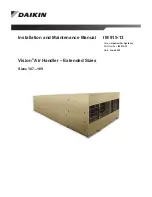
64
SSCBL-RPBL-IOM (10-22) 149159-C
ADJUSTMENTS—CONTINUED
Measure and Adjust Manifold (Outlet) Gas Pressure—Continued
⚠ WARNING ⚠
• Manifold gas pressure must never exceed 3.5 IN WC for natural gas or 10 IN WC for propane gas.
• Before attempting to measure or adjust manifold gas pressure, the inlet (supply) pressure must
be within the specified range for the gas being used, both when the heater is in operation and
when it is on standby. Incorrect inlet pressure could cause excessive manifold gas pressure
immediately or at some future time.
NOTE: A manometer (fluid-filled gauge) is recommended rather than a spring-type gauge due to
the difficulty of maintaining calibration of a spring-type gauge.
1 . With the manual valve (on the combination valve) positioned to prevent flow to the main burners, connect a
manometer to the 1/8-inch pipe outlet pressure tap in the valve .
2 . Open the valve and operate the heater . Measure the gas pressure to the manifold . To measure the low-stage
pressure on units equipped with a two-stage valve, disconnect the wire from the HI terminal on the valve . Be
sure to reconnect the wire .
⚠ CAUTION ⚠
DO NOT bottom out the gas valve regulator screw. This can result in excessive overfire and heat
exchanger failure due to unregulated manifold pressure.
3 . Normally, adjustments to the factory-preset regulator should not be necessary . If adjustment is necessary,
set pressure to correct settings by turning the regulator screw IN (clockwise) to increase pressure or OUT
(counterclockwise) to decrease pressure . Consult the valve manufacturer’s literature provided with the furnace
for more detailed information .
High Elevation (>2,000 Feet/609 Meters) Installations
NOTES:
• High elevation (>2,000 feet/609 meters) application with this unit depends on the installation
elevation and the heating value of the gas. At high elevations, the heating value of natural gas is
always lower than the heating value at sea level.
• Deration is necessary to compensate for low atmospheric pressure at high elevations. Generally
this will require obtaining the gas heating value from the local gas utility and replacing the burner
orifices.
For high elevation (>2,000 feet/609 meters) installations that require orifice replacement, replace the burner orifices
as follows:
1 . Determine model number and rated input (BTUh) from unit’s rating plate .
2 . Determine appropriate orifice replacement (refer to
) for installation elevation .
3 . Unthread existing gas orifices from gas manifold .
⚠ DANGER ⚠
• Do not use Teflon tape or pipe joint compound on the orifice threads. The hole in the orifice may
become blocked and may cause fire, explosion, property damage, carbon monoxide poisoning,
personal injury, or death.
• Use only using factory-supplied orifices. Do not attempt to drill out orifices in the field. Improperly
drilled orifices may cause fire, explosion, carbon monoxide poisoning, personal injury, or death.


































